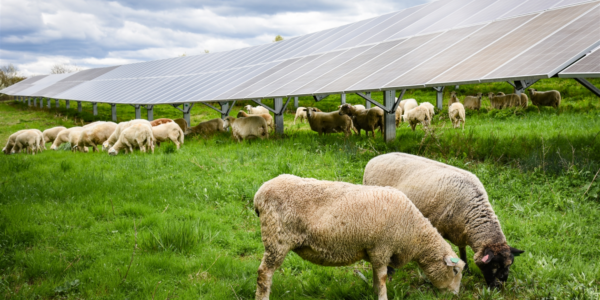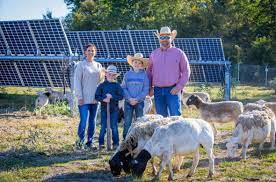From pv magazine USA
Sheep grazers, bee pollinators, solar-tracking hardware vendors, and solar project developers were among the diverse stakeholders represented at the inaugural US agrivoltaics conference last week in Chicago.
The choice of location for Solar Farm Summit 2023, the American heartland, was a focal point of the attendees. Recent policy initiatives promoting active agriculture projects below 10 MW in size include sheep and cow grazing and vegetable and fruit production.
The first Solar Farm Summit, which took place March 14 to 15, drew sheep grazers, seed vendors, and community solar project developers. On the first day of the conference, the summit recorded 460 attendees with printed badges. However, Solar Farm Summit Executive Producer Dan French told pv magazine USA that the real number was likely above 500.
Most attendees expressed a mixed zeal to disbelief that the emerging solar plus farming niche was really taking off, in the form of a conference and small trade show that is, while many attendees hailed from Corn Belt to Mid-Atlantic region universities sought to learn about the various facets of solutions from energy to seed harvesting.
Large-scale developer Silicon Ranch, based in Nashville, showed its first mover advantage in using methods of agrivoltaic solutions over the last few years on southeast to midwestern projects which range from 50 MW to 150 MW and above. The conference appeared to draw new entrants to agrivoltaics, such as EDF Renewables and Savion, which have hired agriculture professionals over recent years to branch into the nascent agrivoltaics market.
Utility-scale sheep
The utility solar market’s presence at the conference showed the initiative and willingness to promote sustainable farming methods and use agrivoltaics technologies like sheep grazing in large solar development. However, a caveat emerged of the dual-use nature of agrivoltaics, which combines on-site solar arrays and producing crops or livestock underneath panel arrays. As a method of creating farm and energy production from a levelised cost of energy (LCOE) perspective, agrivoltaics is best utilised from smaller distributed generation projects like community solar projects that range from about 2 MW to 10 MW on average.
Independent power producers and project developers on projects from 100 MW to 200 MW in power capacity will spend USD 750,000 to USD 950,000 ($1.2 – $1.42 million) on average per year to mow grassy fields and hilly terrain where rows of solar panels can stretch as far as the eye can see, according to the National Renewable Energy Laboratory.

Using solar grazing with the deployment of up to 100 sheep on a solar project site, the use of agrivoltaic solutions would reduce the utility-scale developer’s mowing needs to two mowings per years, and reduce the cost of traditional mowing services to about USD 200,000 from the use of ewes alone, said Loran Shallenberger, director of regenerative energy operations at Silicon Ranch.
Shallenberger told pv magazine USA that scheduled traditional mowing is still required for utility solar projects, especially as the size of such projects continues to grow above 200 MW per project. But capital costs that can range up to USD 1 million on average mowing costs for a large project can be reduced by 20% or about USD 200,000 from the use of sheep herds or other grazing livestock, he said.
Solar grazing in its southeast region typically involves two ewes per acre, so a sample 100 MW solar project that sits on approximately 1,000 acres would require about 2,000 ewes to provide year-round grazing services, Shallenberger said. Silicon Ranch uses ewes on just shy of half of its U.S. solar portfolio, he added.
Various grazers and sheep herding organisations spoke throughout the two-day conference’s sessions, with various farmers showing capacity of up to a few thousand sheep available for dispatch on a variety of regional 10 MW sized projects in the Midwest, Virginia and Pennsylvania.

J.R. Howard, owner of sheep and livestock rancher Texas Solar Sheep and donning an over-sized bucket hat, conveyed the age-old adage of “everything is bigger in Texas,” remains true even for the nascent agrivoltaics market. A previous West Texas oilfield energy foreman, Howard now says his ranching company manages a sheep count of up to 10,000 ewes, able to be deployed across a variety of solar sites across Texas.
In partnership with lightsource BP, Howard’s business grazes up to 2,000 ewes at a 260 MW(DC) utility solar project in Lamar County, Texas. Sheep are grazed in groups of 50 on average, while in rare cases 250 to 500 head may be deployed at one time, Howard said during a Solar Rancher’s Forum panel discussion on March 15.
At the Lightsource BP project, the sheep fleet grazes on 18 pastures across the 260 MW project year-round, with the solar panels providing shade and relief for the sheep grazing crew. The global renewable energy business partly owned by BP reduces its service costs and lowers carbon emissions from solar grazing.
Under grazing agreements, service providers deploying sheep herds on solar sites must adhere to a 24-inch maximum vegetation height on land that is groomed by dozens of ewes, said Silicon Ranch’s Shallenberger.
While Shallenberger and Howard agreed the use of sheep as an agrivoltaic tool for servicing large project down to rural community projects could cause a shortage of sheep over the next year, they pointed to the resilient nature of the sheep’s ecosystem, and require minimal supervision and fencing systems while grazing quadrants of large projects.
Canines such as Border Collies are the go-to pick for solar grazing field shepherds, said Howard and Marcus Gray of Gray’s LambScaping, a regional sheep herder in Virginia. With minimal supervision required, Border Collies are typically able to direct sheep back to a paddock or central location, though occasionally Gray will attach a GPS tracking device to his dogs’ collar, if one of his shepherds is guiding a ewe in a far corner of a thousand-acre solar field and can’t be heard.
Solar grazers said that from community projects located at Susquehanna University to utility-scale solar projects in Texas, annual insurance premiums to cover sheep herds ranges from USD 4,000 to USD 10,000 on average, said Caroline Owens from Owens Farms, a Pennsylvania herder managing a 40-head ewe count, and Lexi Hain, director of agrivoltaics and land management for lightsource BP, a former farmer from Ithaca, N.Y. Byron Komenick, owner of the first U.S. agrivoltaic project, Jack’s Solar Garden, in Longmount, Colo., said in Boulder County his firm pays upwards of USD 25,000 per year to insure his grazing operation.
The burgeoning community solar market in New York state could command an increase in sheep husbrandy and livestock promotion as a solar operations and maintenance solution, as the Empire State currently has about 80,000 sheep, Hain said.
This content is protected by copyright and may not be reused. If you want to cooperate with us and would like to reuse some of our content, please contact: editors@pv-magazine.com.









By submitting this form you agree to pv magazine using your data for the purposes of publishing your comment.
Your personal data will only be disclosed or otherwise transmitted to third parties for the purposes of spam filtering or if this is necessary for technical maintenance of the website. Any other transfer to third parties will not take place unless this is justified on the basis of applicable data protection regulations or if pv magazine is legally obliged to do so.
You may revoke this consent at any time with effect for the future, in which case your personal data will be deleted immediately. Otherwise, your data will be deleted if pv magazine has processed your request or the purpose of data storage is fulfilled.
Further information on data privacy can be found in our Data Protection Policy.